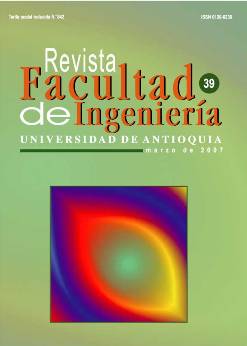Diseño de un sistema biométrico de identificación usando sensores capacitivos para huellas dactilares
DOI:
https://doi.org/10.17533/udea.redin.20187Palabras clave:
binarización, biometría, valles, crestas, esqueletización, filtrado de imágenes, huellas dactilares, identificación, minucias, procesamiento digital de imágenes, sensores capacitivosResumen
Descargas
Citas
http://www.veridicom.com. Consultada el 20 de sep-tiembre de 2005.
http://www.heise.de/ct/english/02/11/114/. Consultada el 20 de septiembre de 2005.
J. R Parker, Algorithms for image processing and computer vision. New York. John Wiley & Sons, Inc. 1997. pp. 176-218.
R. Colmenares del Castillo, Identificación personal dactiloscopia. Instrucciones técnicas para registradores visitadores. Bogotá. Librería Voluntad. 1949. pp. 38-59.
A. Vélez Ángel, Criminalística general. 2.ª ed. Bogotá. Temis. 1963. pp. 60-98.
N. Goodfellow. Dactiloscopia: Sistema de clasificación de archivos. Bogotá. Imprenta Nacional. 1951. pp. 15-38.
Descargas
Publicado
Cómo citar
Número
Sección
Licencia
Los artículos disponibles en la Revista Facultad de Ingeniería, Universidad de Antioquia están bajo la licencia Creative Commons Attribution BY-NC-SA 4.0.
Eres libre de:
Compartir — copiar y redistribuir el material en cualquier medio o formato
Adaptar : remezclar, transformar y construir sobre el material.
Bajo los siguientes términos:
Reconocimiento : debe otorgar el crédito correspondiente , proporcionar un enlace a la licencia e indicar si se realizaron cambios . Puede hacerlo de cualquier manera razonable, pero no de ninguna manera que sugiera que el licenciante lo respalda a usted o su uso.
No comercial : no puede utilizar el material con fines comerciales .
Compartir igual : si remezcla, transforma o construye a partir del material, debe distribuir sus contribuciones bajo la misma licencia que el original.
El material publicado por la revista puede ser distribuido, copiado y exhibido por terceros si se dan los respectivos créditos a la revista, sin ningún costo. No se puede obtener ningún beneficio comercial y las obras derivadas tienen que estar bajo los mismos términos de licencia que el trabajo original.










 Twitter
Twitter